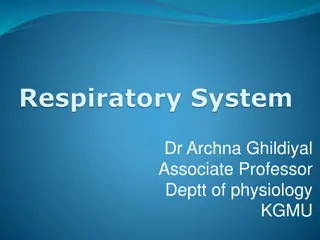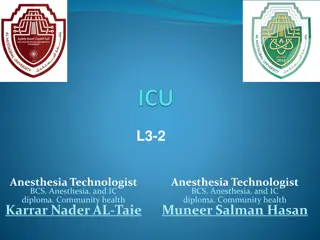Understanding Industrial Ventilation Systems for Workplace Safety
Ventilation plays a crucial role in maintaining a safe working environment by providing fresh air, controlling contaminants, and reducing health risks for workers. This article covers the importance of ventilation, areas at risk of deficiency, components of industrial systems, types of ventilation systems, and tips for improving effectiveness. Safety measures such as dilution and local exhaust ventilation are explained with visual examples to highlight best practices and common mistakes to avoid.
Download Presentation

Please find below an Image/Link to download the presentation.
The content on the website is provided AS IS for your information and personal use only. It may not be sold, licensed, or shared on other websites without obtaining consent from the author. Download presentation by click this link. If you encounter any issues during the download, it is possible that the publisher has removed the file from their server.
E N D
Presentation Transcript
Environmental Control Ventilation IE 449 - Lab
What is ventilation? Ventilation is the provision of fresh air to a room, building, etc. General applications Heating, cooling, and controlling airborne contaminated levels. Heating, ventilating, and air-conditioning (HVAC) Industrial application Controlling toxic and\or flammable contaminates.
Why Ventilation? To prevent or reduce risks of exposing workers to harmful environmental hazards. Environmental hazards could cause severe occupational illnesses and diseases.
Areas with possible ventilation deficiency Confined spaces (tank, chamber, pit, well, tunnel ) Areas with unmaintained ventilation systems. Buildings with no windows. Areas with high occupant densities What to do?? Check by performing measurements.
What are the parts of an industrial ventilation system? Air intake area such as a hood or an enclosure, Ducts to move air from one area to another, Air cleaning device(s), and Fan(s) to bring in outside air and exhaust the indoor contaminated air.
What are the basic types of ventilation systems? Dilution (or general) ventilation reduces the concentration of the contaminant by mixing the contaminated air with clean, uncontaminated air. Local exhaust ventilation captures contaminates at or very near the source and exhausts them outside.
Dilution ventilation Dilution, or "general", ventilation supplies and exhausts large amounts of air to and from an area or building. More effective if the exhaust fan is located close to exposed workers and the makeup air is located behind the worker What s wrong in this picture? worker's breathing zone is in the direction of air flow
Dilution ventilation effectiveness Does not completely remove contaminants. Cannot be used for highly toxic chemicals. Not effective for dusts or metal fumes or large amounts of gases or vapors. Requires large amounts of makeup air to be heated or cooled.
Local exhaust ventilation Local exhaust system is used to control air contaminants by trapping them at or near the source. More effective than dilution system.
When to use local exhaust ventilation Air contaminants pose serious health risk. Large amounts of dusts or fumes are generated. Increased heating costs from ventilation in cold weather are a concern. Emission sources are few in number. Emission sources are near the workers' breathing zones. In a general way, a local exhaust system operates similar to a household vacuum cleaner with the hose as close as possible to the place where dirt would be created.
Relationship between makeup air and exhaust. In Continuously operating process, room dimensions are irrelevant In Short duration exposure, room size will affect dilution
Air flow measurements 1. Thermo Anemometer 2. Air Flow Balometer Capture Hood PEL Permissible Exposure Level (measured in ppm) ppm parts of vapor or gas per million (1,000,000) parts of contaminated air by volume at 25oC
Air cleaning devices To meet external standards (Outdoor Air Quality), air filtration or purification may be necessary to remove particulates from exhaust air. Basic types of particulate removal devices : 1. Centrifugal devices (cyclones): Used for woodworking sawdust, plastic, dusts, and some chemical dray particulates Ex. https://www.youtube.com/watch?v=VGboyQsZiCk
Air cleaning devices Basic types of particulate removal devices : 2. Electrostatic precipitators Used for steel, cement, mining, and chemical industries. Ex. https://www.youtube.com/watch?v=0QWMHxZdPQk
Air cleaning devices Basic types of particulate removal devices : 2. Wet scrubbers: Used in the chemical industries (remove gases and vapors in addition to particulates), rubber, ceramics, foundries and metal cutting industries. Ex. https://www.youtube.com/watch?v=BRNPgPBEzfM
Air cleaning devices Basic types of particulate removal devices : 2. Fabric, or bag-type filters: Used in refining of toxic metals such as lead and in woodworking, metal cutting, rubber, plastics, ceramics, and chemical industries. Ex. https://www.youtube.com/watch?v=4mohzczShuk























